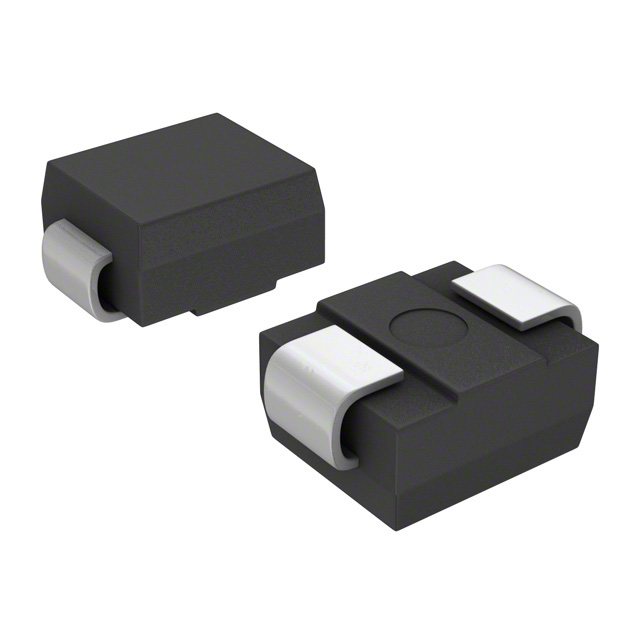Xem thông số kỹ thuật để biết chi tiết sản phẩm.

SMBJ18A-E3/5B
Product Overview
The SMBJ18A-E3/5B belongs to the category of transient voltage suppressor diodes (TVS diodes) and is commonly used for surge protection in electronic circuits. These diodes are characterized by their ability to rapidly respond to overvoltage events, diverting excessive current away from sensitive components. The SMBJ18A-E3/5B is packaged in a compact, surface-mount design, making it suitable for various applications where space is limited. Each package contains a specified quantity of diodes, ensuring convenient and efficient usage.
Specifications
- Voltage Rating: 18V
- Power Dissipation: 600W
- Package Type: DO-214AA (SMB)
- Operating Temperature Range: -55°C to 150°C
- RoHS Compliant: Yes
Detailed Pin Configuration
The SMBJ18A-E3/5B features a standard DO-214AA (SMB) package with two pins. Pin 1 is the cathode, while pin 2 serves as the anode.
Functional Features
- Transient Voltage Suppression: Effectively clamps transient overvoltage events to protect downstream components.
- Fast Response Time: Rapid reaction to overvoltage conditions ensures minimal impact on the circuit.
- Compact Design: Space-saving surface-mount package facilitates easy integration into circuit layouts.
Advantages and Disadvantages
Advantages
- Effective surge protection for sensitive electronic components
- Fast response time enhances system reliability
- Compact form factor ideal for space-constrained applications
Disadvantages
- Limited voltage rating compared to higher-end TVS diodes
- May require parallel or series configuration for higher voltage protection needs
Working Principles
The SMBJ18A-E3/5B operates based on the principle of avalanche breakdown, where it rapidly conducts excess current when the voltage exceeds the rated threshold. This action effectively diverts the surge energy away from the protected circuit, safeguarding against potential damage.
Detailed Application Field Plans
The SMBJ18A-E3/5B finds extensive use in various electronic systems, including: - Telecommunications: Protects communication equipment from voltage transients induced by lightning strikes or power surges. - Industrial Control Systems: Safeguards control circuitry in industrial automation setups from electrical disturbances. - Automotive Electronics: Provides surge protection for automotive control modules and infotainment systems.
Detailed and Complete Alternative Models
For applications requiring different voltage ratings or power dissipation capabilities, alternative TVS diodes include: - SMBJ10A-E3/52 (10V, 600W) - SMBJ24A-E3/52 (24V, 600W) - SMBJ36A-E3/52 (36V, 600W)
In conclusion, the SMBJ18A-E3/5B transient voltage suppressor diode offers effective surge protection in a compact, surface-mount package, making it an essential component in safeguarding electronic circuits from overvoltage events.
Word Count: 398
Liệt kê 10 câu hỏi và câu trả lời thường gặp liên quan đến ứng dụng SMBJ18A-E3/5B trong giải pháp kỹ thuật
What is the SMBJ18A-E3/5B?
- The SMBJ18A-E3/5B is a transient voltage suppressor diode designed to protect sensitive electronic components from voltage spikes and transients.
What is the maximum peak pulse power of the SMBJ18A-E3/5B?
- The maximum peak pulse power of the SMBJ18A-E3/5B is 600 watts.
What is the breakdown voltage of the SMBJ18A-E3/5B?
- The breakdown voltage of the SMBJ18A-E3/5B is 18 volts.
In what applications can the SMBJ18A-E3/5B be used?
- The SMBJ18A-E3/5B can be used in various applications such as telecommunications equipment, industrial automation, automotive electronics, and consumer electronics.
What is the operating temperature range of the SMBJ18A-E3/5B?
- The operating temperature range of the SMBJ18A-E3/5B is -55°C to 150°C.
What are the key features of the SMBJ18A-E3/5B?
- The key features of the SMBJ18A-E3/5B include low clamping voltage, fast response time, and high surge capability.
How does the SMBJ18A-E3/5B provide protection to electronic circuits?
- The SMBJ18A-E3/5B diverts excessive current away from sensitive components during voltage transients, thereby protecting them from damage.
Is the SMBJ18A-E3/5B RoHS compliant?
- Yes, the SMBJ18A-E3/5B is RoHS compliant, making it suitable for use in environmentally conscious designs.
Can the SMBJ18A-E3/5B be used in high-speed data line protection?
- Yes, the SMBJ18A-E3/5B is suitable for high-speed data line protection due to its fast response time and low capacitance.
What are some best practices for incorporating the SMBJ18A-E3/5B into a technical solution?
- Best practices include placing the SMBJ18A-E3/5B as close as possible to the protected circuitry, ensuring proper PCB layout for optimal performance, and verifying compatibility with other components in the system.

